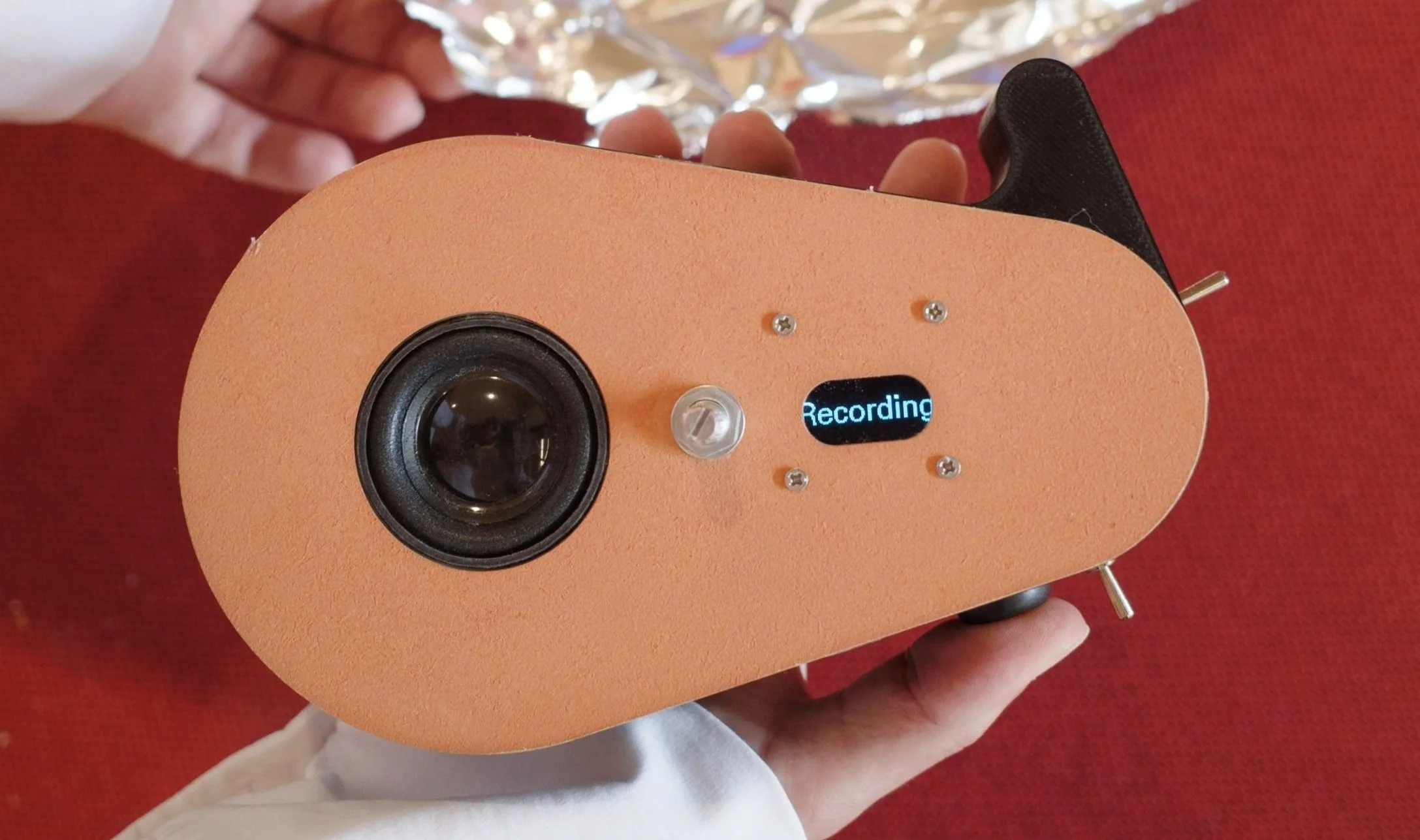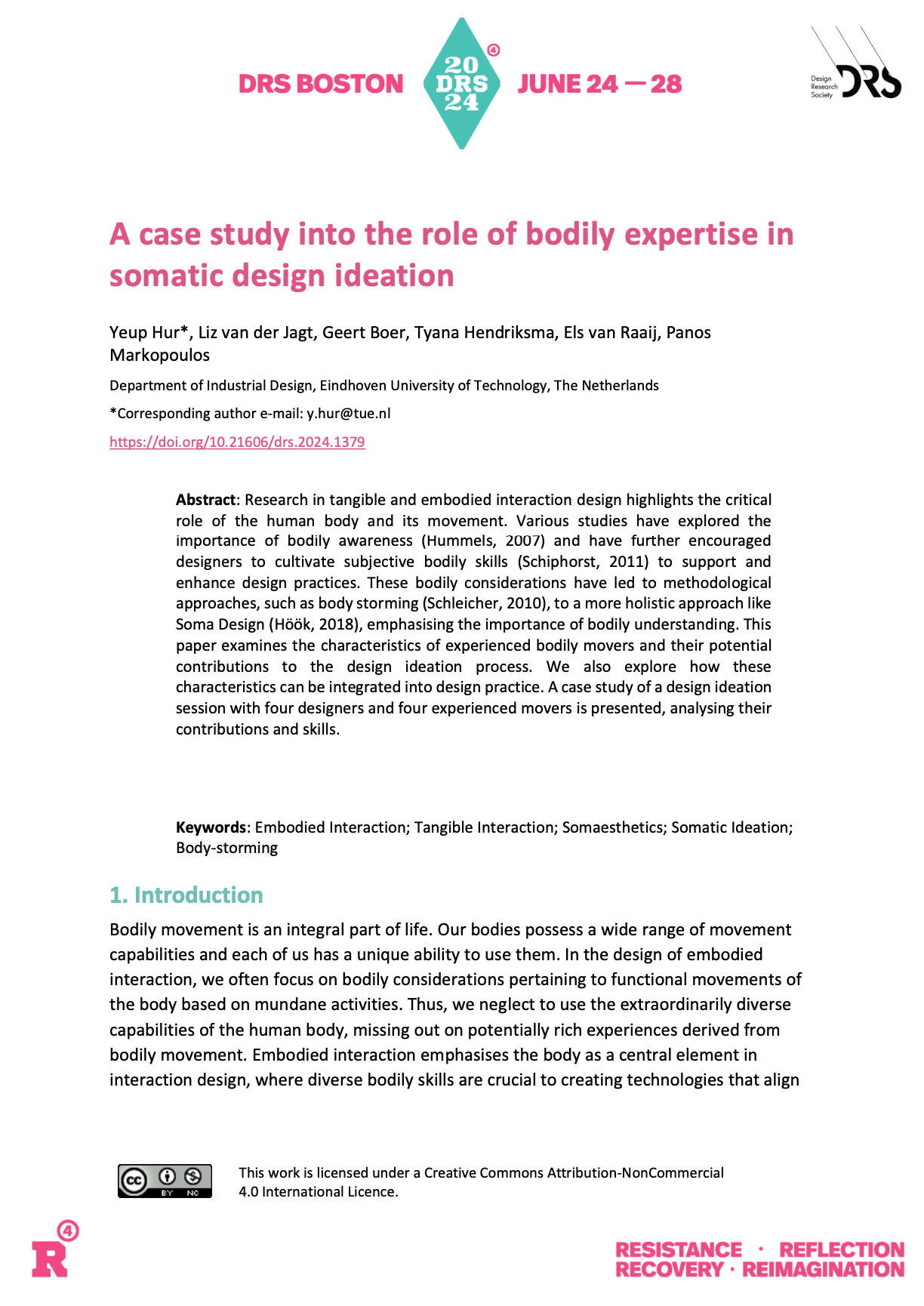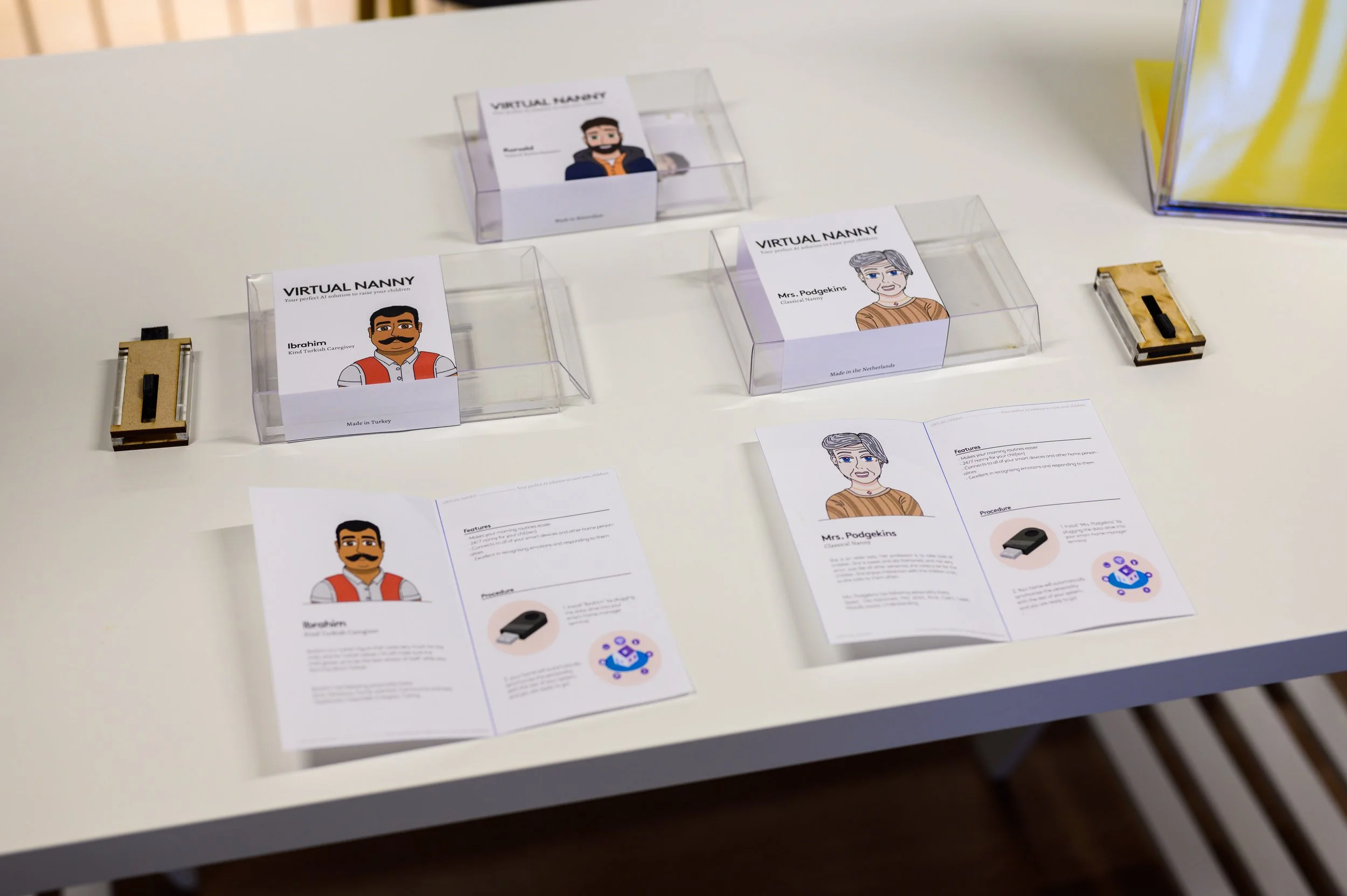Projects through the years
Geert on projects:
“My work is aimed at answering design research questions, using software and hardware as my material for creating interactions that bring theory into practice.”
Final Master Project
Soundit and Ecouter Exercises
Description of Ecouter Exercises
Relationship with my identitiy and vision
Soundit and Ecouter Exercises reflect at their core what I strive for as a designer: Shifting focus from a synthetic world (in this case video editing, learning to use software, searching online for audio to use, ideation via teams and 3rd person perspectives in general) towards the real world (collaborative experience through role-playing, tooling for creative processes and expression usable without intensive time-consuming learning, listening to everyday surroundings and capturing sounds, collaborative in-person ideation and discussion and 1st person perspectives in general). I approached this in “my way”: Through technological design exploration, and also in a way that was less familiar to me: Through designing (and testing) methodology. I believed this mixture of familiarity and novelty seen in my FMP approach reflects my progression as a designer through my FMP and through the master Industrial Design as a whole. I’ve used what I learned before ID, namely embedded software development, and used it as a tool to do design research and interaction design.
Project description
During my FMP I investigated the usage of sound in the designs by TU/e Industrial Design master students.
I followed 'The sound of smart things’, a master design course about the potential role and usage of sound in decentralised systems like IoT systems, as a case study. From this I concluded that whilst TSoST teaches students about theoretical principles of sound effectively, some students have practical issues that impact their learning process negatively.
Conventional tools to record sounds, add audio effects and play them back, are distributed and hard to learn for beginners. This was visible in the fact that some students of TSoST spend more time struggling with software than learning about sound in the context of design. Also, methodology for designerly collaboration and ideation on sound in the context of industrial design and decentralised systems did not exist. The result of this is that students edit a video depicting an everyday scenario and add sound to that, meaning that they are not able to experience sound from a 1st person perspective but only through looking at videos.
To make working with sound more approachable for all designers starting to work with sound (and perhaps beyond), I designed and tested methodology in the form of Ecouter Exercises and tooling in the form of Soundit to overcome these issues.
Ecouter Exercises: A series of role-playing based design exercises to analyse and experiment with sound in the context of decentralised systems of things.
Soundit: An easy-to-use audio recorder that allows for clear playback using a speaker and the usage of audio effects by simply tilting the device.
Both Ecouter Exercises and Soundit have been tested with representative groups of users and results have been promising: User testing showed after only a few minutes of explanation inexperienced users are able to use Soundit to record everyday sounds, play with effects and reflect on the usage of these sounds in a design context. Two separate user tests have shown designers partaking in Ecouter Exercises were able to, through role-playing, analyse a scenario of choice where different sound actors interact, experience the potential usage of sound in this scenario from a 1st person perspective and have an informed and constructive discussion about the usage of sound in this scenario. Both Soundit and Ecouter Exercises could be implemented in the course The sound of smart things, with the aim of teaching the curriculum in a more experience based and interactive way.
Soundit
Soundit demo video
Fontys ICT bachelor
Example project I did for my minor at Fontys:
Interface design to inspire musical creation
Part of my bachelor’s graduation project at Fontys:
Developing granular synthesiser engine for Tasty Chips Electronics
Before the master Industrial Design, I studied Information & Communication Technology at Fontys University of Applied Science in Eindhoven. Here I followed the tracks embedded software development and open innovation, an open education form where students work on projects of choice: Somewhat similar to Industrial Design, albeit the projects always have a software focus.
Towards the end of my bachelor I got inspired by the work of Teenage Engineering and I shifted my focus to devices that make sound. During my graduation internship I worked for a Dutch company that creates granular synthesisers.
The experience at this small Dutch synthesizer company was inspirational: Three people, led by one person, created musical instruments almost completely in-house: Enabling people all over the world to make music in new ways, namely using hardware granular synthesizer. But, it was also a very technology focussed company. This was reflected in their utilitarian designs.
I felt their approach to aesthetic design and user experience, whilst successful in terms of sales, could be improved even further in terms of interaction design. But, I did not have the skills and knowledge to back this up. For this reason (among others), I chose to start the master Industrial Design at TU/e: To learn about how people work with things and how to play with interaction between humans & technology.
Research contribution A case study into the role of bodily expertise in somatic design ideation
Main learnings: Design research experience, learning and reflection on design methodologies.
During the course Research Methods in the master ID at TU/e, given by Panos Markopoulos, I was part of a group that researched the implications of having a dance/movement related background when doing a Somaesthetics design ideation workshop. For this course/research a user test has been done that as been analysed as a case study for the implications of whether a designer has a movement related background or not. From this we concluded that the more a person is comfortable with bodily expression, the higher the quality of the output of the somaesthetic ideation. The reason for this being that people who are more comfortable with bodily expression are able to express movement and interaction in more detail through their own bodily movement.
The course deliverable paper draft was later iterated on in collaboration with Brandon Heup, a researcher at TU/e. The final paper has been submitted to DRS 2024 and has been accepted. Upon publishing the paper can be found at https://doi.org/10.21606/drs.2024.1379.
Moving Mirror
M11 project ‘Moving Mirror’ in action
Main learnings: Using sensor data to create a novel interaction, use my technical skills in a design context and for a serious problem, learning to realise a mechanical electrically-controlled construction.
During M11 I came up with the idea for Moving Mirror: A mirror for people with depression.
Depression patients tend to neglect themselves, without these patients realising it. Moving Mirror uses an eye-sensor to track where people are looking in the mirror. If people are not looking at themselves in the mirror, the mirror tilts away too, amplifying the effect of not looking at yourself.
It was based on perceptual crossing, but on oneself instead of between two actors: Something that could be considered ‘self perceptual crossing’.
It reflects my vision of moving away from ‘synthetic’ interactions and shifting focus towards what actually matters: You. It is a comment on digital interfaces that analyse data and tell you “how you are doing”. Instead, Moving Mirror responds directly to the users gaze and leaves the ‘interpretation of the data’ over to the human user.
VisiDrum
VisiDrum being used in a musical performance by Gion van den Broek.
Main learnings: Personal exploration into my design identity, multimodality: combining visual and audio modalities, building a bigger electrical construction, working with external (outside of TU/e) users.
During the first attempt at M21 I created a MIDI-based music visualiser for electronic music performances.
VisiDrum is unique because the lights are triggered by an electrical connection to a drum machine: The lights visualise the drum hits instead of a representation of the sound. This makes for a very direct and more specific way of ‘seeing’ music, more close to what is visible when seeing a band.
An attempt at de-synthesizing electronic music events where people are just watching a DJ turn knobs. The aim of VisiDrum was to give musical meaning to what an audience sees when seeing an electronic musician perform.
Interactive Materiality
Project for Interactive Materiality in action
Technology for Interactive Materiality
Main learnings: Material explorations, exploration of the usage of sound in an unexpected way to strengthen an interaction between human and material.
During the project for Interactive Materiality the goal was to pick a material and explore it’s communicative potential. During this grou[ project I focussed on how to use the properties of the material for auditive feedback.
For this I created a system that controlled an audio recording’s playback according to how our material was moving. This resulted in an impressive interaction that could not only be felt and seen, but heard as well. The way the material twitches as it was moved and touched could be heard too, resulting in a unique experience.
I was proud of this project, since it was a group effort where my expertise shined in the final product and where I could make my mark by the way sound was implemented, whist at the same time creating a novel interaction.
Personal project
Music Visualisation
Music visualisations in action
Main learnings: Deploying my design outside of university, working with external parties, visual aesthetics.
In this project I used hardware I made during M21 to create hypnotic music visualisation. I used Fourier transform to show frequencies in music in a very specific and low-latency way. This approach made for a unique, mesmerising effect, through which sometimes even specific musical events like vocal parts could be seen at the same time it was heard. During deployment I received a lot of positive feedback, with visitors calling the lights “hypnotic” and “mesmerising”. A spare time project driven by curiosity.
Virtual Nanny Project
Project for Interactive Materiality in action
Technology for Interactive Materiality
Main learnings: speculative design.
During the group project for Researching the future everyday we created Virtual Nanny, a speculative AI product that would take over the role of a parent.
Virtual Nanny would be a piece of software to be installed in the house of parents with young children. The idea was that instead of having to hire a nanny, the software would pick up parental tasks such as cooking and dressing the children, but also listen to and advise on children’s problems when the parents would be away or have no time.
Our stance in this project was, akin to my vision, thay society is prepared to give too much responsibility to ‘black-box’ entities such as Instagram or Chat-GPT. To have a conversation on this topic, we set out to cross that line: By making fake products, flyers and pretending to sell this Virtual Nanny software as if it were an amazing practical idea.
Virtual Nanny sparked heated discussion, with one lecturer even calling our idea ‘horrible’ saying we should not spend attention on developing concepts this inhumane. I found it an amazing projects, because I also think a ‘virtual nanny’ is a crazy idea we should be wary of. But I believe recognising such possible futures and considering them in design is a way of preventing dystopian futures from becoming reality.
This project was an inspiration because it is an exercise of looking into the future, something very important to do in design, but very difficult: Who can truly predict the future? Lessons that I will carry with me for sure.
FUTURE
During the master I learned to create with purpose and to validate my designs. I also learned to apply these skills beyond ‘just making’: To do design research. I still get very excited about topics like music and creativity, but I leaned other topics like design research and education excite me as well.
In the future I see myself doing design research. I would like to keep exploring novel human-technology interactions with the goal of finding out what’s possible and shaping the way people use technology in everyday lives. I would see myself doing a PhD in the context of HTI and music/sound, or working at a smaller company where it is possible to be involved in larger parts of the design process.









